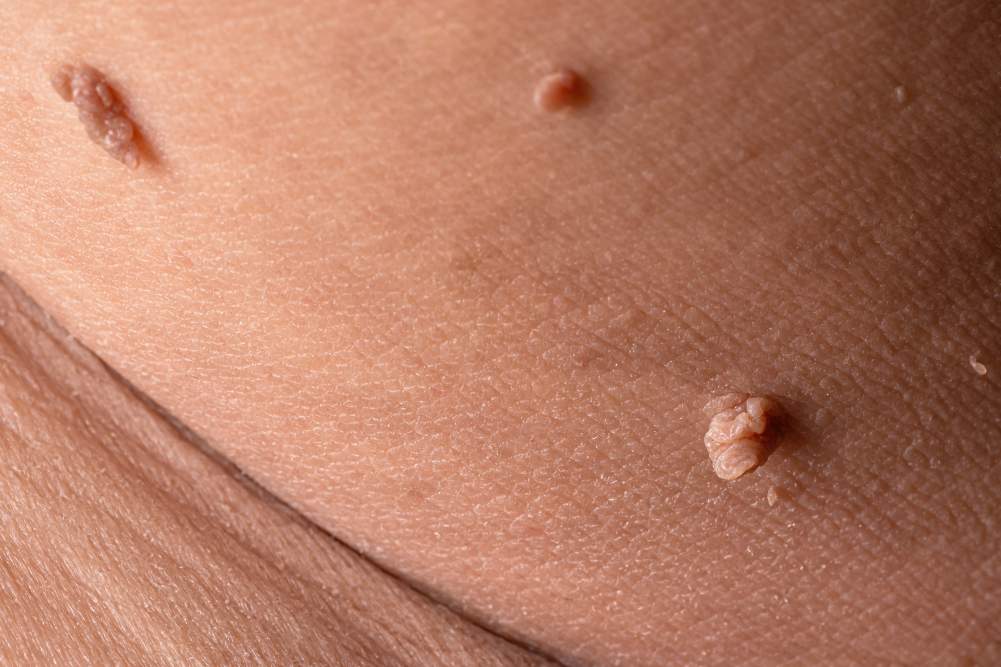Skin Tags
Aurora Dermatology is delighted to provide a new, minimally-invasive laser procedure for skin tag removal – a walk-in walk-out procedure that has very little downtime.

What is a skin tag?
- A skin tag is a soft, generally harmless lesion that hangs off the skin on a stalk, or sometimes looks like a small fleshy grape.
- Skin tags may also be called acrochordon, papilloma, pedunculated (stalk like), a fibroepithelial polyp, or a soft fibroma.
- The good news is that skin tags can be removed swiftly and easily in the dermatologist’s rooms.
Where do skin tags occur?
- Skin tags can occur anywhere on the body commonly under the armpits, breast folds, anus, on the eyelids, or in other folds of skin where skin tags tend to form.
- A skin tag may also occur in the neck
- Skin tags are very common
What causes skin tags?
- The cause is largely unknown, however it’s thought skin tags may develop when the skin rubs together or is irritated by clothing or jewellery (think armpits, thighs, anus, eyelids and neck)
- They are also more common in overweight people who have folds of skin
- Family history and genetics may play a role
- There is no medical need to remove a skin tag, but many people have them removed for cosmetic reasons or because they are very large, possibly painful and get in the way of daily activities.
Skin tags may be more common in people with too much insulin or an indicator for high cholesterol in people with type 2 diabetes.
Can you safely remove small skin tags yourself?
- Never remove your own skin tag with a razor, tweezers or scissors, as you put your body at risk of infection and rarely what you think may be a skin tag, could potentially be a more dangerous skin cancer, tumour or blood clot.
- It is always important to ensure your skin tag is seen by a qualified doctor. Skin tags also have a vascular source and removing them may lead to uncontrolled bleeding.
- Dr Parisa says while some people claim vinegar, tea tree oil or clear nail polish remover remove skin tags, that these treatments are largely unproven in large clinical trials, and that the gold standard of skin tag treatment is removal in the doctor’s surgery.
- It is also always a good idea to get your doctor or dermatologist to check if a skin tag is not in fact a skin cancer or something else.
How should I prepare for my skin tag laser removal procedure?
- Skin tags are generally a walk-in and walk-out procedure that can be removed in under an hour in rooms, often on the same day as diagnosis (no special tests required).
- Patients receive a numbing medication around the area to reduce pain, the skin is removed, and a sterile solution is applied to the skin.
- Dr Parisa will determine the most suitable way to remove your skin tags.
This may include
Cryotherapy – where they are frozen off with liquid nitrogen, or diathermy or physical removal CO2
Laser Treatment – where the tag is burnt off with laser is the most suitable option with less chance of scarring. - Learn more about our CO2 laser here.
* Disclaimer. Individual results may vary. All procedures have risks, so discuss the benefits of skin tag removal with your doctor.
Sources:
DermNet: Skintags
Incidence of skin tags, Healthline
Research Gate: Skin Tags and Atherogenic Lipid Profile in Diabetes Mellitus Type 2 in Jabir Abu Eliz Diabetes Center

